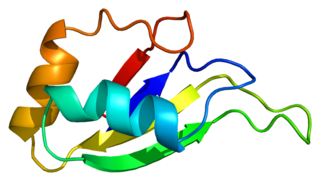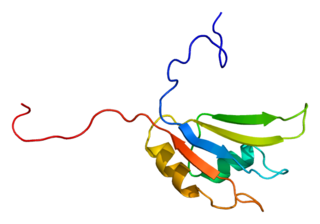Related Research Articles

Nucleoproteins are proteins conjugated with nucleic acids. Typical nucleoproteins include ribosomes, nucleosomes and viral nucleocapsid proteins.
RNA-binding proteins are proteins that bind to the double or single stranded RNA in cells and participate in forming ribonucleoprotein complexes. RBPs contain various structural motifs, such as RNA recognition motif (RRM), dsRNA binding domain, zinc finger and others. They are cytoplasmic and nuclear proteins. However, since most mature RNA is exported from the nucleus relatively quickly, most RBPs in the nucleus exist as complexes of protein and pre-mRNA called heterogeneous ribonucleoprotein particles (hnRNPs). RBPs have crucial roles in various cellular processes such as: cellular function, transport and localization. They especially play a major role in post-transcriptional control of RNAs, such as: splicing, polyadenylation, mRNA stabilization, mRNA localization and translation. Eukaryotic cells express diverse RBPs with unique RNA-binding activity and protein–protein interaction. According to the Eukaryotic RBP Database (EuRBPDB), there are 2961 genes encoding RBPs in humans. During evolution, the diversity of RBPs greatly increased with the increase in the number of introns. Diversity enabled eukaryotic cells to utilize RNA exons in various arrangements, giving rise to a unique RNP (ribonucleoprotein) for each RNA. Although RBPs have a crucial role in post-transcriptional regulation in gene expression, relatively few RBPs have been studied systematically.It has now become clear that RNA–RBP interactions play important roles in many biological processes among organisms.

rRNA 2'-O-methyltransferase fibrillarin is an enzyme that in humans is encoded by the FBL gene.

Heterogeneous nuclear ribonucleoprotein A1 is a protein that in humans is encoded by the HNRNPA1 gene. Mutations in hnRNP A1 are causative of amyotrophic lateral sclerosis and the syndrome multisystem proteinopathy.

snRNP70 also known as U1 small nuclear ribonucleoprotein 70 kDa is a protein that in humans is encoded by the SNRNP70 gene. snRNP70 is a small nuclear ribonucleoprotein that associates with U1 spliceosomal RNA, forming the U1snRNP a core component of the spliceosome. The U1-70K protein and other components of the spliceosome complex form detergent-insoluble aggregates in both sporadic and familial human cases of Alzheimer's disease. U1-70K co-localizes with Tau in neurofibrillary tangles in Alzheimer's disease.

Heterogeneous nuclear ribonucleoprotein D0 (HNRNPD) also known as AU-rich element RNA-binding protein 1 (AUF1) is a protein that in humans is encoded by the HNRNPD gene. Alternative splicing of this gene results in four transcript variants.

Heterogeneous nuclear ribonucleoproteins C1/C2 is a protein that in humans is encoded by the HNRNPC gene.

Synaptotagmin-binding, cytoplasmic RNA-interacting protein (SYNCRIP), also known as heterogeneous nuclear ribonucleoprotein (hnRNP) Q or NS1-associated protein-1 (NSAP-1), is a protein that in humans is encoded by the SYNCRIP gene. As the name implies, SYNCRIP is localized predominantly in the cytoplasm. It is evolutionarily conserved across eukaryotes and participates in several cellular and disease pathways, especially in neuronal and muscular development. In humans, there are three isoforms, all of which are associated in vitro with pre-mRNAs, mRNA splicing intermediates, and mature mRNA-protein complexes, including mRNA turnover.

U1 small nuclear ribonucleoprotein A is a protein that in humans is encoded by the SNRPA gene.

Heterogeneous nuclear ribonucleoprotein H is a protein that in humans is encoded by the HNRNPH1 gene.

Nucleolysin TIAR is a protein that in humans is encoded by the TIAL1 gene.

HuD otherwise known as ELAV-like protein 4 is a protein that in humans is encoded by the ELAVL4 gene.

Heterogeneous nuclear ribonucleoprotein R is a protein that in humans is encoded by the HNRNPR gene.

Heterogeneous nuclear ribonucleoprotein D-like, also known as HNRPDL, is a protein which in humans is encoded by the HNRPDL gene.

ELAV-like protein 2 is a protein that in humans is encoded by the ELAVL2 gene.

Polypyrimidine tract-binding protein 1 is a protein that in humans is encoded by the PTBP1 gene.
Post-transcriptional regulation is the control of gene expression at the RNA level. It occurs once the RNA polymerase has been attached to the gene's promoter and is synthesizing the nucleotide sequence. Therefore, as the name indicates, it occurs between the transcription phase and the translation phase of gene expression. These controls are critical for the regulation of many genes across human tissues. It also plays a big role in cell physiology, being implicated in pathologies such as cancer and neurodegenerative diseases.

Prp24 is a protein part of the pre-messenger RNA splicing process and aids the binding of U6 snRNA to U4 snRNA during the formation of spliceosomes. Found in eukaryotes from yeast to E. coli, fungi, and humans, Prp24 was initially discovered to be an important element of RNA splicing in 1989. Mutations in Prp24 were later discovered in 1991 to suppress mutations in U4 that resulted in cold-sensitive strains of yeast, indicating its involvement in the reformation of the U4/U6 duplex after the catalytic steps of splicing.

RNA recognition motif, RNP-1 is a putative RNA-binding domain of about 90 amino acids that are known to bind single-stranded RNAs. It was found in many eukaryotic proteins.

In molecular biology, the La domain is a conserved protein domain.
References
- 1 2 3 4 5 6 "Jack Keene, PhD – Biography". Duke University. Retrieved 5 November 2019.
- 1 2 Doyle, Francis; Tenenbaum, Scott A. (15 April 2014). "Trans-regulation of RNA-binding protein motifs by microRNA". Frontiers in Genetics. 5: 79. doi: 10.3389/fgene.2014.00079 . PMC 4006066 . PMID 24795744.
- 1 2 3 4 5 6 7 8 9 10 11 12 13 Hamilton, John D. (February 10, 2015). The History of Infectious Diseases At Duke University In the Twentieth Century. Lulu Publishing Services. pp. 139–140. ISBN 9781483423753 . Retrieved 23 February 2020.
- 1 2 Culjkovic-Kraljacic, Biljana; Borden, Katherine L. B. (5 November 2018). "The Impact of Post-transcriptional Control: Better Living Through RNA Regulons". Frontiers in Genetics. 9: 512. doi: 10.3389/fgene.2018.00512 . PMC 6230556 . PMID 30455716.
- 1 2 Sanford, Jeremy R.; Penalva, Luiz O. F. (29 November 2017). "The 3′ end of the story: deciphering combinatorial interactions that control mRNA fate". Genome Biology. 18 (1): 227. doi:10.1186/s13059-017-1360-6. PMC 5707901 . PMID 29187223.
- 1 2 3 4 5 6 7 8 Center for Oral History. "Jack D. Keene". Science History Institute .
- 1 2 3 4 Thackray, Arnold; Morris, Stephanie; Caruso, David (2008). Jack D. Keene, Transcript of an Interview Conducted by Arnold Thackray, Stephanie Morris, and David Caruso at Ixtapa, Mexico, and Johns Hopkins University, Baltimore, Maryland on 5 March 1989 and 23 and 25 April 2008. Philadelphia, PA: Chemical Heritage Foundation.
- ↑ "Jack Donald Keene". Scholars @ Duke University. Retrieved 8 February 2020.
- ↑ Keene, J. D. (January 2007). "Biological Clocks and the Coordination Theory of RNA Operons and Regulons". Cold Spring Harbor Symposia on Quantitative Biology. 72 (1): 157–165. doi: 10.1101/sqb.2007.72.013 . PMID 18419273.
- ↑ Keene, Jack D. (April 2010). "Minireview: Global Regulation and Dynamics of Ribonucleic Acid". Endocrinology. 151 (4): 1391–1397. doi:10.1210/en.2009-1250. PMC 2850242 . PMID 20332203.
- ↑ Wagner, Robert R. (June 29, 2013). The Rhabdoviruses. Springer Science & Business Media. pp. 139–140. ISBN 9781468470321.
- ↑ Keene, J. D.; Schubert, M.; Lazzarini, R. A.; Rosenberg, M. (1 July 1978). "Nucleotide sequence homology at the 3' termini of RNA from vesicular stomatitis virus and its defective interfering particles". Proceedings of the National Academy of Sciences. 75 (7): 3225–3229. Bibcode:1978PNAS...75.3225K. doi: 10.1073/pnas.75.7.3225 . PMC 392747 . PMID 210454.
- ↑ Deflubé, Laure R.; Cressey, Tessa N.; Hume, Adam J.; Olejnik, Judith; Haddock, Elaine; Feldmann, Friederike; Ebihara, Hideki; Fearns, Rachel; Mühlberger, Elke (23 April 2019). "Ebolavirus polymerase uses an unconventional genome replication mechanism". Proceedings of the National Academy of Sciences. 116 (17): 8535–8543. doi: 10.1073/pnas.1815745116 . PMC 6486738 . PMID 30962389.
- ↑ Kiley, Michael P.; Wilusz, Jeffrey; Mc Cormick, Joseph B.; Keene, Jack D. (March 1986). "Conservation of the 3′ terminal nucleotide sequences of Ebola and Marburg virus". Virology. 149 (2): 251–254. doi:10.1016/0042-6822(86)90127-3. PMID 3946083.
- ↑ Lazzarini, Robert A.; Keene, Jack D.; Schubert, Manfred (October 1981). "The origins of defective interfering particles of the negative-strand RNA viruses". Cell. 26 (2): 145–154. doi:10.1016/0092-8674(81)90298-1. PMID 7037195.
- ↑ Loerch, Sarah; Kielkopf, Clara L. (September 2015). "Dividing and Conquering the Family of RNA Recognition Motifs: A Representative Case Based on hnRNP L". Journal of Molecular Biology. 427 (19): 2997–3000. doi:10.1016/j.jmb.2015.06.009. PMC 4820351 . PMID 26101840.
- ↑ Kattah, Nicole H.; Kattah, Michael G.; Utz, Paul J. (January 2010). "The U1-snRNP complex: structural properties relating to autoimmune pathogenesis in rheumatic diseases". Immunological Reviews. 233 (1): 126–145. doi:10.1111/j.0105-2896.2009.00863.x. PMC 3074261 . PMID 20192997.
- ↑ Query, C (October 1987). "A human autoimmune protein associated with U1 RNA contains a region of homology that is cross-reactive with retroviral p30gag antigen". Cell. 51 (2): 211–220. doi:10.1016/0092-8674(87)90148-6. PMC 3074261 . PMID 2959371.
- ↑ Habets, WJ; Hoet, MH; Sillekens, PT; De Rooij, DJ; Van de Putte, LB; Van Venrooij, WJ (May 1989). "Detection of autoantibodies in a quantitative immunoassay using recombinant ribonucleoprotein antigens". Clinical and Experimental Immunology. 76 (2): 172–7. PMC 1541836 . PMID 2527098.
- ↑ Chambers, J. C.; Keene, J. D. (1 April 1985). "Isolation and analysis of cDNA clones expressing human lupus La antigen". Proceedings of the National Academy of Sciences. 82 (7): 2115–2119. Bibcode:1985PNAS...82.2115C. doi: 10.1073/pnas.82.7.2115 . PMC 397503 . PMID 3856888.
- ↑ Simone, Laura E; Keene, Jack D (February 2013). "Mechanisms coordinating ELAV/Hu mRNA regulons". Current Opinion in Genetics & Development. 23 (1): 35–43. doi:10.1016/j.gde.2012.12.006. PMC 3617084 . PMID 23312841.
- ↑ Bevilacqua, Annamaria; Ceriani, Maria Cristina; Capaccioli, Sergio; Nicolin, Angelo (June 2003). "Post-transcriptional regulation of gene expression by degradation of messenger RNAs". Journal of Cellular Physiology. 195 (3): 356–372. doi: 10.1002/jcp.10272 . PMID 12704645.
- ↑ Mansfield, Kyle D.; Keene, Jack D. (March 2012). "Neuron-specific ELAV/Hu proteins suppress HuR mRNA during neuronal differentiation by alternative polyadenylation". Nucleic Acids Research. 40 (6): 2734–2746. doi:10.1093/nar/gkr1114. PMC 3315332 . PMID 22139917.
- ↑ Keene, J. D. (19 June 2001). "Ribonucleoprotein infrastructure regulating the flow of genetic information between the genome and the proteome". Proceedings of the National Academy of Sciences. 98 (13): 7018–7024. Bibcode:2001PNAS...98.7018K. doi: 10.1073/pnas.111145598 . PMC 34616 . PMID 11416181.
- ↑ Aparicio, Luis A.; Abella, Vanessa; Valladares, Manuel; Figueroa, Angélica (29 May 2013). "Posttranscriptional regulation by RNA-binding proteins during epithelial-to-mesenchymal transition". Cellular and Molecular Life Sciences. 70 (23): 4463–4477. doi: 10.1007/s00018-013-1379-0 . PMC 3827902 . PMID 23715860.
- ↑ Keene, Jack D. (July 2007). "RNA regulons: coordination of post-transcriptional events" (PDF). Nature Reviews Genetics. 8 (7): 533–543. doi:10.1038/nrg2111. PMID 17572691 . Retrieved 8 February 2020.
- ↑ Wang, Li; Miao, Yi-Liang; Zheng, Xiaofeng; Lackford, Brad; Zhou, Bingying; Han, Leng; Yao, Chengguo; Ward, James M.; Burkholder, Adam; Lipchina, Inna; Fargo, David C.; Hochedlinger, Konrad; Shi, Yongsheng; Williams, Carmen J.; Hu, Guang (December 2013). "The THO Complex Regulates Pluripotency Gene mRNA Export and Controls Embryonic Stem Cell Self-Renewal and Somatic Cell Reprogramming". Cell Stem Cell. 13 (6): 676–690. doi:10.1016/j.stem.2013.10.008. PMC 3962795 . PMID 24315442.
- ↑ Pulendran, Bali; Katsikis, Peter D.; Schoenberger, Stephen P., eds. (August 19, 2011). Crossroads between Innate and Adaptive Immunity III. Springer Science & Business Media. pp. 1–3. ISBN 9781441956323 . Retrieved 24 February 2020.
- ↑ Larsson, Ola; Nadon, Robert (April 1, 2009). "Gene Expression - Time to change point of view?". In Harding, Stephen (ed.). Biotechnology & Genetic Engineering Reviews. Vol. 25. Nottingham University Press. pp. 86–87. ISBN 9781904761662.
- ↑ "Jack D. Keene, Ph.D." The Pew Charitable Trusts. Retrieved 23 February 2020.